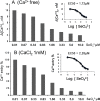Selenium maintains Ca2+ homeostasis in sheep lymphocytes challenged by oxidative stress
- PMID: 30059547
- PMCID: PMC6066243
- DOI: 10.1371/journal.pone.0201523
Selenium maintains Ca2+ homeostasis in sheep lymphocytes challenged by oxidative stress
Abstract
Selenium (Se) is an essential element in human and animal diets, based upon a widespread range of beneficial effects that are primarily due to its antioxidant properties. While Se can be associated to anti-cancer and anti-diabetic activities, reproductive efficiency, and enhancement of the immune system, the mechanistic details of the corresponding biological processes are still largely elusive. To avoid deficiencies and increase bioavailability, Se it is generally supplied to livestock through Se-supplemented feeds or forage plants fertilized with inorganic Se. While the relationship between Ca2+ and ROS (reactive oxygen species) is well known, only a few studies have addressed the possible involvement of Se in the control of cytosolic Ca2+ in oxidative stress. The results on Ca2+ homeostasis were obtained adding exogenous Se in the form of SeO42- to sheep lymphomonocytes cultured in vitro. In particular, Se strongly attenuated 1mM H2O2-induced alteration of intracellular [Ca2+]C as well as the entry of extracellular Ca2+ into the cells with comparable EC50 values for sodium selenate accounting to 1.72 and 2.28 mM, respectively. In an ex vivo trial, it was observed that Ca2+ homeostasis can effectively be rescued in sheep lymphomonocytes exposed in vivo to a Se concentration of approximately 1.9 mM, that was achieved by feeding sheep with olive leaves previously sprayed with 500 mg/plant Na-selenate. Thus the results obtained suggest that the mode of action of selenium markedly influenced Ca2+-related signaling events. Furthermore, results clearly reveal that the protective effect of Se on Ca2+ homeostasis under oxidative challenge can be clearly and effectively achieved through an appropriate dietary regimen obtained also in a circular economy logic using pruning of olive trees treated to reduce tree drought stress.
Conflict of interest statement
The authors have declared that no competing interests exist.
Figures




Similar articles
-
Selenium maintains cytosolic Ca2+ homeostasis and preserves germination rates of maize pollen under H2O2-induced oxidative stress.Sci Rep. 2019 Sep 18;9(1):13502. doi: 10.1038/s41598-019-49760-3. Sci Rep. 2019. PMID: 31534157 Free PMC article.
-
Selenium-Enriched Pollen Grains of Olea europaea L.: Ca2+ Signaling and Germination Under Oxidative Stress.Front Plant Sci. 2019 Dec 11;10:1611. doi: 10.3389/fpls.2019.01611. eCollection 2019. Front Plant Sci. 2019. PMID: 31921256 Free PMC article.
-
Use of Selenium-enriched olive leaves in the feed of growing rabbits: Effect on oxidative status, mineral profile and Selenium speciation of Longissimus dorsi meat.J Trace Elem Med Biol. 2019 Jan;51:98-105. doi: 10.1016/j.jtemb.2018.10.004. Epub 2018 Oct 6. J Trace Elem Med Biol. 2019. PMID: 30466946
-
Selenium: a double-edged sword for defense and offence in cancer.Arch Toxicol. 2010 Dec;84(12):919-38. doi: 10.1007/s00204-010-0595-8. Epub 2010 Sep 25. Arch Toxicol. 2010. PMID: 20871980 Review.
-
Selenium as an important factor in various disease states - a review.EXCLI J. 2022 Jul 5;21:948-966. doi: 10.17179/excli2022-5137. eCollection 2022. EXCLI J. 2022. PMID: 36172072 Free PMC article. Review.
Cited by
-
The antioxidant barrier, oxidative/nitrosative stress, and protein glycation in allergy: from basic research to clinical practice.Front Immunol. 2024 Dec 5;15:1440313. doi: 10.3389/fimmu.2024.1440313. eCollection 2024. Front Immunol. 2024. PMID: 39703514 Free PMC article. Review.
-
Selective Inhibition of Wild Sunflower Reproduction with Mugwort Aqueous Extract, Tested on Cytosolic Ca2+ and Germination of the Pollen Grains.Plants (Basel). 2021 Jul 3;10(7):1364. doi: 10.3390/plants10071364. Plants (Basel). 2021. PMID: 34371567 Free PMC article.
-
Selenium maintains cytosolic Ca2+ homeostasis and preserves germination rates of maize pollen under H2O2-induced oxidative stress.Sci Rep. 2019 Sep 18;9(1):13502. doi: 10.1038/s41598-019-49760-3. Sci Rep. 2019. PMID: 31534157 Free PMC article.
-
Persistence of the Effects of Se-Fertilization in Olive Trees over Time, Monitored with the Cytosolic Ca2+ and with the Germination of Pollen.Plants (Basel). 2021 Oct 25;10(11):2290. doi: 10.3390/plants10112290. Plants (Basel). 2021. PMID: 34834652 Free PMC article.
-
In Vitro Oxidative Stress Threatening Maize Pollen Germination and Cytosolic Ca2+ Can Be Mitigated by Extracts of Emmer Wheatgrass Biofortified with Selenium.Plants (Basel). 2022 Mar 24;11(7):859. doi: 10.3390/plants11070859. Plants (Basel). 2022. PMID: 35406839 Free PMC article.
References
-
- Djanaguiraman M, Devi DD, Shanker AK, Sheeba JA, Bangarusamy U. Selenium—an antioxidative protectant in soybean during senescence. Plant and Soil, 2005, 272 (issue 1–2): 77–86. 10.1007/s11104-004-4039-1 - DOI
-
- Wang C, Yang S, Zhang N, Mu Y, Ren H, Wang Y, et al. Long-Term supra nutritional supplementation with selenate decreases hyperglycemia and promotes fatty liver degeneration by inducing hyperinsulinemia in diabetic db/db mice. PLoS One, 2014. 9 (7): e101315 10.1371/journal.pone.0101315 - DOI - PMC - PubMed
Publication types
MeSH terms
Substances
LinkOut - more resources
Full Text Sources
Other Literature Sources
Miscellaneous

